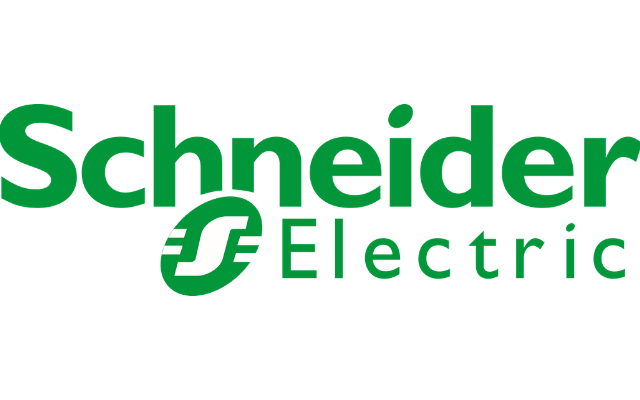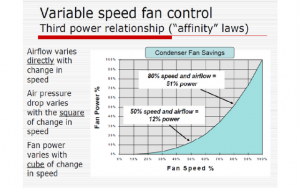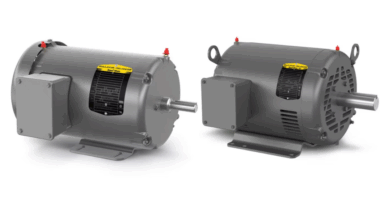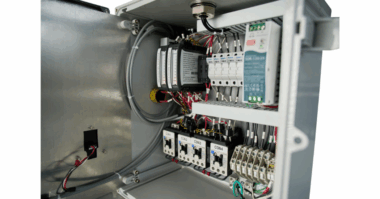By: Bob Gray
For reducing energy consumption of the HVAC systems in the typical building, can we say that it is a “no brainer” to apply Variable Speed Drives on everything from pumps to fans? See Figure-1, following) Traditionally, fans and pumps have been two of the major targets for implementing Energy Conservation Measures (ECM) within a facility.
VSDs provide us with a means to operate the fan or pump much more energy efficiently. We have heard it said that the only way to achieve additional energy savings over a VSD, is to turn the pump or fan “off”. This is not really true, as you will see in this article. This article will only focus on the “AC” part of the HVAC systems.
Over the past decade, the HVAC market focus regarding energy conservation has been quick and easy applications of variable speed drives applied to the HVAC pumps and fans within a building. Substantial energy has been saved through the application of VSDs.
Moving forward, we need to expand on what we have leaned over the years plus advancements in IIOT to take our HVAC system’s efficiency to the next level, by digging deeper within the AC mechanical system components. We can do this by looking deep within the control strategy and algorithms of the HVAC equipment itself. Through implementing ways of enhancing the internal operational characteristics of the AC equipment, and then operating the VSDs applied to the pump and fan motors to compliment that operation, we can take our control strategy to the next level.
EXAMPLE – 1: Air-cooled chiller supplying chilled water to a commercial building.
In more recent years, HVAC OEMs have applied a VSD to the condenser fans in an effort to help save energy and reduce short cycling of the compressors during lower outside air temperature conditions. Using the VSD in this case, we can isolate a single circuit or stage of the compressor and better maintain the fixed head pressure to avoid short cycling. This operation keeps the compressor online to provide mechanical cooling to appease the load.
Why not take the application of the VSD to the next level by controlling all of the condenser fans of both or all three of the refrigerant circuits, plus, incorporate floating high (head) pressure control as well. By taking advantage of less than design outside air conditions, we can monitor outside air Temperature/wet bulb, plus high and low side refrigerant pressures, and applying a Floating High Pressure control algorithm, we can reduce the condensing temperature within the condenser, which reduces the lift on the compressors, which reduces the energy consumption and substantially adds to the energy savings potential. So now, we have taken the application of the VSDs to the next level by creating a less stressful mechanical environment in which the compressors can operate. (See figure-2)
This addition of adding the Floating High Pressure control to the mix can save up to 30% of the total energy consumption of the chiller. We can also apply VSDs to the chilled water pump motor, using the same microprocessor/controller we’ve used for the condenser fan control to monitor the delta-t of the chilled water loop. The control algorithm resets the chilled water flow, based on the delta-t of supply and return temperatures of the chilled water loop. Of course we have to make sure we have met the OEM’s minimum chilled water flow requirements through the evaporator of the chiller.
We can also apply Variable Speed Control to the compressor(s) and further reduce the energy consumption of the chiller. This must be done via precise control software algorithms within the microprocessor/controller while monitoring key operational parameters and incorporating compressor manufacturer guidelines in an effort to protect the compressor via proper oil return, and maintaining proper operational pressures and temperatures. Schneider Electric’s ATV-212 is preconfigured for effective and safe compressor speed control.
To apply effective Floating High Pressure control, we would want to monitor via the microprocessor/controller the outside air temperature, plus the high and low pressure values of each refrigerant circuit of the air-cooled chiller, as we vary the speed of the condenser fans.
Example – 2: Water-cooled chiller supplying chilled water to a commercial building.
As in Example – 1, we can apply the same principle for controlling the chilled water pumps, adding to that, the condenser water pumps as well. In this application we can use the same controller to control the speed of the cooling tower fan(s) and reset the condenser water temperature. Reducing the condenser water temperature reduces the lift on the compressor which in turn substantially reduces the energy consumption. The same monitoring points we stated for the air-cooled example must be used with the water-cooled chiller as well, however, we would want to monitor outside air wet-bulb temperature instead of dry-bulb as in the case with the air-cooled chiller example.
An understanding of the OEM’s of minimum and maximum pressures and temperatures requirements must be applied using the software algorithm in an effort protect the equipment and not allow the chiller to surge .
In both examples, you have taken systems with individual loops of control, provided synergy by bringing them together into a single control operation that sees the complete system as opposed to just a single isolated control loop. After the controls retrofit, the control loops are working together, as opposed to controlling just individual and independent control loops.
The really interesting thing about this control approach, is that it can be added as a retrofit to existing chiller plants, without replacing your AC equipment. If you have AC equipment that is mechanically sound, applying this as a retrofit would bring your older equipment up to the efficiency standards of newer AC equipment all for a fraction of the cost of equipment replacement. For most retrofit applications, the typical ROI is less than 3-years.
For both air cooled and water cooled chillers, in applying Floating High Pressure control you are extending the life of your AC equipment as well through providing a less mechanically stressful “environment” for the compressors to operate within. Reducing compressor lift requirements in both air-cooled and water-cooled chiller systems reduces the “mechanical strain” on the compressor(s), plus helps to alleviate short cycling during cooler outside air conditions. Applying a VSD to the compressor for Variable Refrigerant Control enhances efficiency even further, however, that will be the subject of a separate article.
Another benefit, utilizing the new control technology, we have made it possible to communicate to the BMS typically already in place through one of the popular protocols such as Bacnet, Modbus and Lonworks. This means we can more readily have access to our system’s compressors, pumps and fans performance remotely.
Through the embedded web-server in the Schneider Electric M172 HVAC/R Controller line, you have the opportunity/capability to take remote monitoring to a higher level through “Cloud” or IIOT technology. This feature is also a tremendous Service Tool for the on-site HVAC Technician. This will be the subject of an additional article at a later date, however, I will say now that this technology helps you to not only apply predictive and diagnostic intervention remotely for the AC equipment, but also assures the AC equipment is operating at optimum efficiency.
For help in selecting the right controller for you AC System, please visit the following web page:
https://www.schneider-electric.us/en/work/solutions/machine-control/hvac/
Schneider Electric’s ATV-212 is a premium drive for AC applications including fans, pumps and Variable Speed Compressors Visit the following web page for selecting the right Variable Frequency Drive for your specific application:
https://www.schneider-electric.com/en/product-category/2900-variable-speed-drives-and-soft-starters/
 The ATV-212 performance is certified by AHRI. To be sure the drive you intend to use has the AHRI Certification of Performance, look for the following seal:
The ATV-212 performance is certified by AHRI. To be sure the drive you intend to use has the AHRI Certification of Performance, look for the following seal:
You can go to the AHRI official website and obtain the latest data on the ATV-212 and other performance certified drives from various drive manufacturers:
https://www.ahridirectory.org/Search/QuickSearch?category=9&searchTypeId=3&producttype=37
So, through implementing a deep control strategy for our compressors, pumps and fans, we have avoided the costs of new mechanical equipment while at the same time: 1. Prolonged the life of that equipment, 2. Brought our system efficiency up to a level rivaling the latest and greatest new equipment and systems offered on the market today. 3. Achieved this for a fraction of the cost of replacement. Now I say that is “such a deal”!






